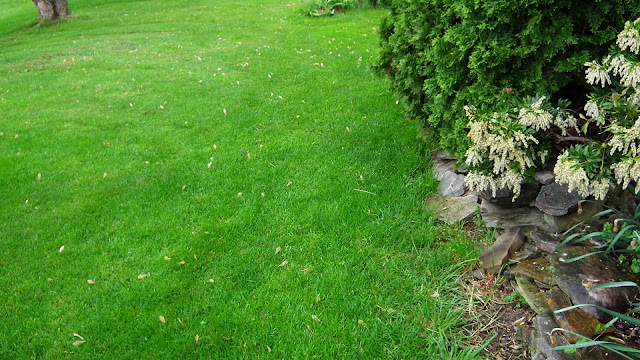Welcome! Italy, Lebanon, Taiwan, Armenia, China, and the Netherlands. Up to 57 countries.
My lawn on April 22, 2012
 |
| Rain started last night, will be prettier in a couple of days |
Many years ago we had a lawn that was ugly and filled with weeds. I called a lawn company in to start a program to fix it. I had little lawn knowledge back then. I enjoy mowing, so it was usually me pushing the mower and then sitting on the lawn tractor when we moved up to that.
My husband was always telling me that I was cutting the grass too short - "scalping it." I of course ignored him because I was the one cutting and if you cut shorter you don't have to cut as often - right?
OMG! He was right. After my MG training I changed the way I do almost everything in my yard.
I learned that if you get a soil sample and adjust your Ph to 6.5 you solve a lot of problems. I tested my soil 2 years ago. Ph was 5.5. Explained the bare spots and moss growth. Followed the recommendations and added 80 pounds of lime per 1000 square feet. Kicker was, you can only add 50 pounds at a time. I did 50 # in the fall of 2010 and then the other 30 # in the spring.
I learned that if you cut your grass to a height of 3 inches, you can stop a lot of weed germination because the sun is not hitting your soil to start the germination process.
I learned that you should only cut 1/3 of the grass blade so you do not stress the plant.
I learned that if your lawn company is spraying for insects, you do not see any butterflies or birds in your yard.
I learned that if you aerate your lawn, more oxygen and water can get to the roots of your turf and make it healthier and stronger.
I learned that if you do not collect the clippings and leave it on the lawn you can cut back on your fertilization. The grass decomposes and returns nitrogen to your lawn.
I learned that if you don't rake your leaves and mow them with a mulching mower (or mulching attachment to your mower) you are adding much need organic matter to your soil. Also it is wonderful food for the worms.
I learned that if you don't water your lawn during a drought it will go dormant and then turn green again when the rains come back.
l learned that thatch build up is due to shallow watering not leaving grass clippings on the lawn. When people water less than 1" it stimulates shallow root growth. If you water, make sure you give at least 1" so the roots can grow deep into the soil, not along the surface.
I learned that the best time to seed your lawn is late August or September.
If you to to www.hgic.umd.edu and choose "publications" in the left column, then choose "Free publications online" you can scroll down and spend hours and hours reading about lawn care.
Bottom line, please do not add more fertilizer or pesticides than is specified on the directions on the bag. That gets washed into the Chesapeake Bay. Same with any chemical that ends up on a hard surface, driveways and sidewalks.
Well, I now mow high and often. I fertilize in the fall only. I do use an organic lawn fertilizer, it is not as quick to green up the lawn, but I feel that the plants are not as stressed.
I will use round up for poison ivy and bermuda grass, the other weeds I mow or cut out with a knife before they go to seed. They then get thrown into my compost bin. The rule of thumb is - if you let a weed go to seed, you're fighting those seeds for 7 years.
My lawn is no longer ugly, or weed ridden. It does have some weeds, but I am ok with that. The neighbor to the right cuts her lawn to the ground. Filled with weeds. Neighbor to the left uses the lawn company I used about 6 years ago. His lawn is dark green and weed free. He is also paying about $1000 a year.
The birds are back because there are bugs and worms to eat. The butterflies are incredible! Every year there are more and more. I think the addition of native plants and flowers have done a lot, but the absence of pesticides is truly the key.
 |
| Nest being built outside my bedroom window |
A few pictures I took yesterday:
 |
| Japanese maple off of deck |
 |
| Wall slowly being covered up |
 |
| view leaving my neighborhood |
 |
| farm I pass every day for the last 30 years |
 |
| field in fog |







































